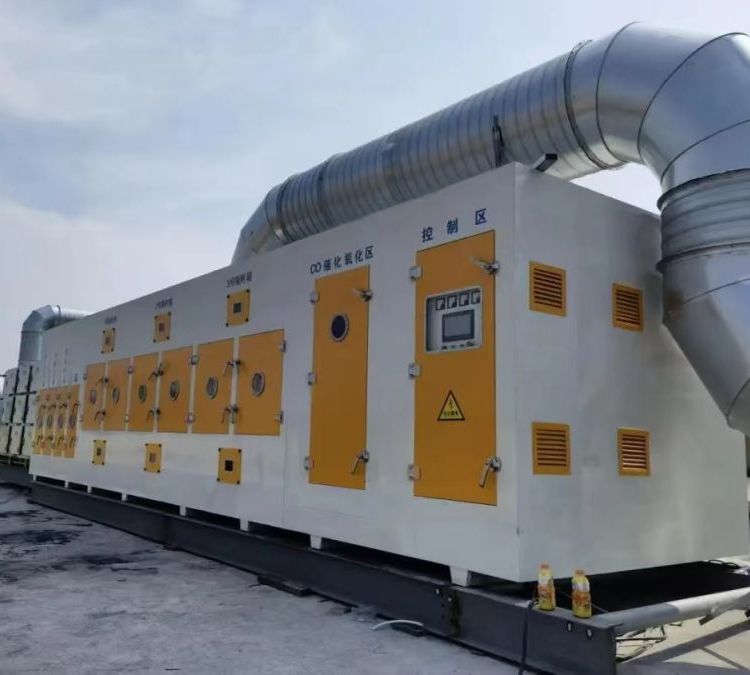 地图 - 热线
地图 - 热线
 地图 - 热线
地图 - 热线
- 服务热线 - 15392885678 15069779222
工业涂装车间是工业制造业的污染源之一,产生的VOCs若不进行必要的无害化处理,随意排放,会对环境带来严重的污染。本文将介绍涂装废气沸石转轮RTO工艺的工作原理。
The industrial painting workshop is one of the sources of pollution in the industrial manufacturing industry. If the VOCs generated are not treated harmlessly and discharged indiscriminately, they will cause serious pollution to the environment. This article will introduce the working principle of the zeolite rotary RTO process for coating waste gas.
1.涂装有机废气介绍:
1. Introduction to organic waste gas from painting:
涂装所用的涂料主要由树脂、助剂、颜填料、溶剂组成,其中成膜物质主要包含树脂、颜填料,溶剂主要起稀释、混合、分散树脂、颜填料的作用,使树脂与颜填料充分混合、不凝聚,降低沉降速率。涂料所使用溶剂的主要成份为苯、甲苯、乙苯、二甲苯、乙酸乙酯、乙酸丁酯等。涂料在喷涂、挥发、烘干过程中溶剂、助剂会逐渐挥发出来,形成有机废气(VOC)。有机废气排放到大气中,在一定条件下通过光化学反应,对臭氧层造成严重破坏,影响大气质量,同时若长期在含有高浓幅度有机废气环境中工作,会损害人的中枢神经系统严重影响作业人员的健康。
The coatings used for painting are mainly composed of resin, additives, pigments and fillers, and solvents. The film-forming substances mainly include resin and pigments and fillers, and the solvents mainly play a role in diluting, mixing, and dispersing the resin and pigments and fillers, so that the resin and pigments and fillers are fully mixed and do not aggregate, reducing the settling rate. The main components of solvents used in coatings are benzene, toluene, ethylbenzene, xylene, ethyl acetate, butyl acetate, etc. During the spraying, volatilization, and drying processes of coatings, solvents and additives will gradually evaporate, forming organic waste gases (VOCs). Organic waste gas is emitted into the atmosphere, and under certain conditions, it causes serious damage to the ozone layer through photochemical reactions, affecting air quality. At the same time, if working in an environment containing high concentrations of organic waste gas for a long time, it will damage the central nervous system and seriously affect the health of workers.

2.沸石转轮RTO工艺介绍:
2. Introduction to zeolite rotary RTO process:
近几年,从国家到地方,均越来越重视环境污染问题,各个地方在依照国家标准的基础上均不同程度的颁布了针对涂装行业的挥发性有机物排放控制标准,在标准内部对VOC最高允许排放浓度及排放总量均作出严格要求。通过标准的严格实施,促使相关企业对环保设施进行改造及技术升级,并促进行业的技术进步。涂装行业针对有机废气比较常用的处理方式以沸石转轮RTO焚烧为例。沸石转轮浓缩加焚烧主要分为沸石浓缩和RTO焚烧两部分,首先是通过沸石转轮吸附大风量喷漆室废气中的低浓度VOC,然后采用小风量高温气体将吸附在沸石转轮上的VOC脱附出来,形成小风量高浓度的VOC气流,然后通过引风机将脱附后的高浓度有机蒸汽送到RTO,有机蒸汽中的苯系物、烷烃类分子在RTO内被高温氧化成CO2和H2O,达到净化有机蒸汽的目的。
In recent years, both the national and local governments have attached increasing importance to environmental pollution issues. Each region has issued varying degrees of volatile organic compound emission control standards for the painting industry based on national standards, and has made strict requirements for the maximum allowable VOC emission concentration and total emission amount within the standards. By strictly implementing standards, relevant enterprises are encouraged to renovate and upgrade their environmental protection facilities, and promote technological progress in the industry. The commonly used treatment method for organic waste gas in the coating industry is zeolite rotary RTO incineration. Zeolite wheel concentration and incineration are mainly divided into two parts: zeolite concentration and RTO incineration. Firstly, the zeolite wheel adsorbs low concentration VOCs in the exhaust gas of the high air volume spray booth. Then, a low air volume high-temperature gas is used to desorb the VOCs adsorbed on the zeolite wheel, forming a low air volume high concentration VOC gas flow. The desorbed high concentration organic vapor is then sent to the RTO through an induced draft fan. The benzene and alkane molecules in the organic vapor are oxidized at high temperature in the RTO to CO2 and H2O, achieving the purpose of purifying the organic vapor.
3.沸石转轮RTO工艺原理
3. Principle of zeolite rotary RTO process
沸石转轮浓缩吸附是利用沸石分子具有晶体、多孔的结构特征,将有机废气分子和空气分子选择性吸附后达到进化空气的目的。沸石分子表面为固体骨架,各个孔穴之间由孔道相互连接,气体分子可由孔道穿过,由于孔穴的结晶特性,使得分子筛的孔道分布均匀,孔径大小较为均一。气体分子经过孔道时,会根据晶体内部孔径的大小对分子进行选择性吸附,较大的分子被吸附在晶体表面,小分子经过孔道成为洁净空气,因此沸石转轮也被称为“分子筛”。沸石“分子筛”具有很大的比表面积,这些表面积主要在晶穴内部,外表面积仅占总表面积的1%左右,因此具有极强的吸附功能,能够有效吸附烃类和烷烃类等较小的极性较强的VOC类有机物分子。
Zeolite rotary wheel concentration adsorption utilizes the crystalline and porous structural characteristics of zeolite molecules to selectively adsorb organic waste gas molecules and air molecules to achieve the goal of evolving air. The surface of zeolite molecules is a solid skeleton, and the pores are connected to each other by pores. Gas molecules can pass through the pores. Due to the crystallization characteristics of the pores, the pore distribution of the molecular sieve is uniform, and the pore size is relatively uniform. When gas molecules pass through the pores, they selectively adsorb based on the size of the pore size inside the crystal. Larger molecules are adsorbed on the surface of the crystal, while smaller molecules become clean air through the pores. Therefore, zeolite wheels are also known as "molecular sieves". Zeolite "molecular sieve" has a large specific surface area, which is mainly located inside the crystal cavity, with the outer surface area accounting for only about 1% of the total surface area. Therefore, it has extremely strong adsorption function and can effectively adsorb smaller and more polar VOC organic molecules such as hydrocarbons and alkanes.
沸石转轮分为吸附区、脱附区和冷却区,大风量低浓度的有机蒸汽经过吸附区后,有机分子被吸附在分子筛的表面,当吸附到一定程度之后,用小风量的高温气体进行反向吹扫,将有机分子从分子筛中脱离出来,同时用部分低浓度的有机蒸汽对分子筛进行降温,通过以上步骤将有机蒸汽浓缩、分离,将大风量低浓度的有机蒸汽转变为高浓度、低风量的废气。沸石转轮具有如下特点:结构紧凑、体积小;单位体积吸附量大,系统总处理风量大;蜂窝结构空气阻力小、系统压力损失低,结构强度高、使用寿命长,能实现吸附,脱附的连续处理,适应大风量,连续作业场所。
The zeolite wheel is divided into an adsorption zone, a desorption zone, and a cooling zone. After the high air volume and low concentration organic vapor pass through the adsorption zone, the organic molecules are adsorbed on the surface of the molecular sieve. After adsorption to a certain extent, a low air volume high-temperature gas is used for reverse blowing to remove the organic molecules from the molecular sieve. At the same time, some low concentration organic vapor is used to cool the molecular sieve. Through the above steps, the organic vapor is concentrated and separated, and the high air volume and low concentration organic vapor is converted into high concentration and low air volume waste gas. The zeolite wheel has the following characteristics: compact structure and small volume; The adsorption capacity per unit volume is large, and the total processing air volume of the system is large; Honeycomb structure has low air resistance, low system pressure loss, high structural strength, long service life, and can achieve continuous treatment of adsorption and desorption. It is suitable for high air volume and continuous work environments.
RTO,是利用辅助燃料系统,把可燃的有害气体的温度提高到反应温度,从而使有害气体分子发生氧化分解,达到气体净化目的的专业设备。废气焚烧炉按热量回收方式的不同分直燃式废气焚烧炉(TNV)和蓄热式废气焚烧炉(RTO),从节省能源的角度考虑,多采用蓄热废气焚烧炉。
RTO, It is a professional equipment that uses an auxiliary fuel system to raise the temperature of combustible harmful gases to the reaction temperature, thereby causing the oxidation and decomposition of harmful gas molecules, achieving the purpose of gas purification. Waste gas incinerators are divided into direct combustion waste gas incinerators (TNV) and regenerative waste gas incinerators (RTO) according to different heat recovery methods. From the perspective of energy conservation, regenerative waste gas incinerators are often used.
本文由沸石转轮+RTO友情奉献.更多有关的知识请点击:http://www.tdyhhb.com真诚的态度.为您提供为全面的服务.更多有关的知识我们将会陆续向大家奉献.敬请期待.
This article is contributed by the friendship of zeolite wheel and RTO. For more related knowledge, please click: http://www.tdyhhb.com Sincere attitude. We provide you with comprehensive services. We will gradually contribute more relevant knowledge to everyone. Please stay tuned

截屏,微信识别二维码